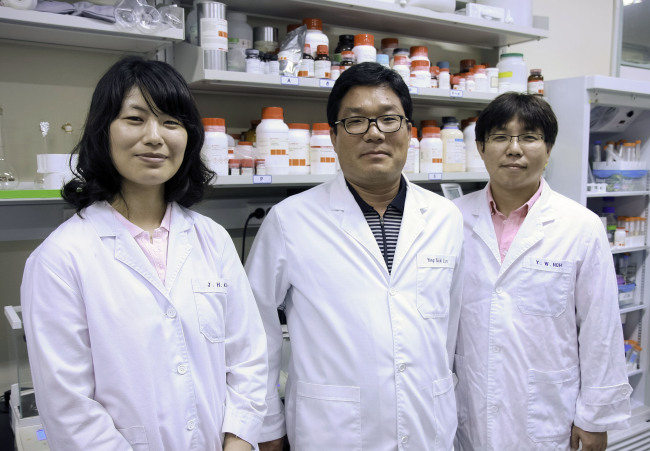Local research team overcomes limitations in cancer immunotherapy
A local research team has succeeded in developing a new method for treating cancer using materials found naturally in the human body.
Advances in the medical sciences over the years have given rise to radiotherapy and to numerous different chemicals for treating cancer.
While such methods have dramatically increased the chance of survival for cancer patients, medical professionals have been searching for alternatives due to the severe side effects of chemo and radiotherapy.
One such method is immunotherapy which uses a patient’s immune system to treat a condition. In immunotherapy cancer treatments the immune system is stimulated to increase its response to antigens specific to cancer cells.
An antibody is a protein produced by a type of white blood cell that is designed to recognize and bind to specific antigens. Once antibodies bind to an antigen, the molecule is processed by other components of the immune system.
While the method developed by the team led by professor Lim Yong-taik of Chungnam National University’s Graduate School of Analytical Science and Technology is essentially the same as previously developed processes, the method differs in that it addresses two of the main obstacles faced by immunotherapy.
A local research team has succeeded in developing a new method for treating cancer using materials found naturally in the human body.
Advances in the medical sciences over the years have given rise to radiotherapy and to numerous different chemicals for treating cancer.
While such methods have dramatically increased the chance of survival for cancer patients, medical professionals have been searching for alternatives due to the severe side effects of chemo and radiotherapy.
One such method is immunotherapy which uses a patient’s immune system to treat a condition. In immunotherapy cancer treatments the immune system is stimulated to increase its response to antigens specific to cancer cells.
An antibody is a protein produced by a type of white blood cell that is designed to recognize and bind to specific antigens. Once antibodies bind to an antigen, the molecule is processed by other components of the immune system.
While the method developed by the team led by professor Lim Yong-taik of Chungnam National University’s Graduate School of Analytical Science and Technology is essentially the same as previously developed processes, the method differs in that it addresses two of the main obstacles faced by immunotherapy.

While it avoids complications associated with chemo and radiotherapy, the application and efficacy of immunotherapy has so far been limited due to the immune system-suppressing characteristic of cancer cells. In addition, as the method requires the cancer antigen to be introduced into the patient’s system, its application has been limited to a small number of cancers whose antigenic information has been subjected to extensive research.
Unlike the conventional immunotherapy methods, Lim and his team used two nucleic acid molecules to bypass the two hurdles.
Nucleic acids refer to deoxyribonucleic acid or DNA and ribonucleic acid or RNA.
In their experiments, the team attached a piece of single-stranded DNA known as CpG oligodeoxynucleotide, also known as CpG ODN, to a piece of double-stranded RNA known as short interfering RNA or siRNA.
When the conjugate was injected into mice with cancer the immune response against cancer cells increased by up to eight-fold compared to mice injected only with the CpG ODN.
Under normal conditions DNA is found in a double helix form where two strands that have complimentary sequence of nucleotides pair up, while most RNA molecules consist of single strands.
In addition to its double-stranded form, a siRNA differs to other forms of RNA in that it suppresses a gene’s expression. This is achieved by one of the strands of the siRNA binding to the target gene, thereby preventing the gene from being expressed.
A gene is expressed in two stages. In the first stage a type of RNA is produced using the information contained in the gene in the form of specific nucleotide sequence. Other types of RNA then arrange amino acids ― the building blocks of proteins ― in the order dictated by the sequence of nucleotides in the first RNA molecule.
In Kim’s method, siRNA specific to a gene known as STAT3, which encodes the information for a protein that regulates the expression of molecules involved in signaling the immune system.
The CpG ODN is a short sequence of nucleotides characterized by the cytosine followed by guanine.
Due to its abundance in the genetic material of microorganisms and its scarcity in humans, the cytosine-guanine sequence stimulates an immune response.
The CpG ODN is recognized by immune cells including dendritic cells, whose function is to process antigenic materials and present it on their surface, which in turn stimulates other types of immune cells to attack the cells that produced the antigen.
By Choi He-suk (cheesuk@heraldcorp.com)
-
Articles by Korea Herald



![[Exclusive] Korean military set to ban iPhones over 'security' concerns](http://res.heraldm.com/phpwas/restmb_idxmake.php?idx=644&simg=/content/image/2024/04/23/20240423050599_0.jpg&u=20240423183955)




![[Pressure points] Leggings in public: Fashion statement or social faux pas?](http://res.heraldm.com/phpwas/restmb_idxmake.php?idx=644&simg=/content/image/2024/04/23/20240423050669_0.jpg&u=)

![[Herald Interview] 'Amid aging population, Korea to invite more young professionals from overseas'](http://res.heraldm.com/phpwas/restmb_idxmake.php?idx=644&simg=/content/image/2024/04/24/20240424050844_0.jpg&u=20240424200058)









